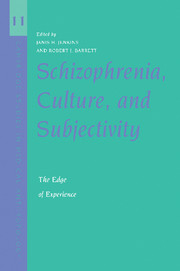Book contents
- Frontmatter
- Contents
- Contributors
- Preface
- Acknowledgments
- Schizophrenia, Culture, and Subjectivity
- Introduction
- Part 1 Culture, Self, and Experience
- 1 Schizophrenia as a Paradigm Case for Understanding Fundamental Human Processes
- 2 Interrogating the Meaning of “Culture” in the WHO International Studies of Schizophrenia
- 3 Kurt Schneider in Borneo: Do First Rank Symptoms Apply to the Iban?
- 4 Living Through a Staggering World: The Play of Signifiers in Early Psychosis in South India
- 5 In and Out of Culture: Ethnographic Means to Interpreting Schizophrenia
- Part 2 Four Approaches for Investigating the Experience of Schizophrenia
- Part 3 Subjectivity and Emotion
- Index
- References
2 - Interrogating the Meaning of “Culture” in the WHO International Studies of Schizophrenia
Published online by Cambridge University Press: 25 January 2010
- Frontmatter
- Contents
- Contributors
- Preface
- Acknowledgments
- Schizophrenia, Culture, and Subjectivity
- Introduction
- Part 1 Culture, Self, and Experience
- 1 Schizophrenia as a Paradigm Case for Understanding Fundamental Human Processes
- 2 Interrogating the Meaning of “Culture” in the WHO International Studies of Schizophrenia
- 3 Kurt Schneider in Borneo: Do First Rank Symptoms Apply to the Iban?
- 4 Living Through a Staggering World: The Play of Signifiers in Early Psychosis in South India
- 5 In and Out of Culture: Ethnographic Means to Interpreting Schizophrenia
- Part 2 Four Approaches for Investigating the Experience of Schizophrenia
- Part 3 Subjectivity and Emotion
- Index
- References
Summary
An Epidemiological Provocation
Field studies of mental disorders date from the 1920s; discussion of the difficulties inherent in such comparative work, from the late 1950s (Hammer and Leacock 1961). In 1967, the WHO initiated a set of studies investigating the manifestation, consequences, and course of schizophrenia and related disorders. Since then, nearly thirty research sites, spanning nineteen countries, have participated in one or more of them. The two main studies – the International Pilot Study of Schizophrenia (IPSS, beginning 1967) and the Determinants of Outcome of Severe Mental Disorder (DOSMeD, beginning 1978), with initial follow-up periods ranging from two to five (and, in several sites, ten) years – have consistently found persons clinically diagnosed with schizophrenia and related disorders in the industrialized West to have less favorable outcomes than counterparts in developing countries. Although the number of distinctive “cultures” was small,the resiliency of this finding, extensively documented and assessed with increasingly sophisticated instruments, is noteworthy – arguably the more so for emerging from such anthropologically suspect ground. (When within-group variation is so extensive and changes over time, contrast effects between groups are likely to be muted and the probability of Type II error – missing real difference when it is there –rises.)
But it was far from clear that the pronounced differences seen in short-term follow-up would hold up over time. Nor was this the only problem. The analytic adequacy (let alone empirical fidelity) of such labels as “developed” and “developing” were questioned (Hopper 1991; Edgerton and Cohen 1994).
- Type
- Chapter
- Information
- Schizophrenia, Culture, and SubjectivityThe Edge of Experience, pp. 62 - 86Publisher: Cambridge University PressPrint publication year: 2003
References
- 9
- Cited by



